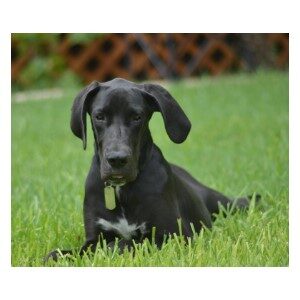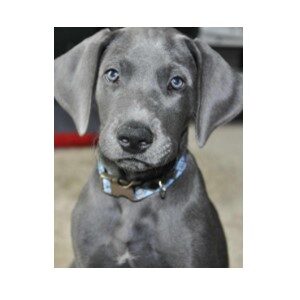Great Dane Dog Bed
Your Great Dane Needs a Orthopedic Bed!
Introduction
Great Dane dog bed take into account their health, personal preferences and sleeping position when selecting a dog bed. An orthopedic bed is the best choice. Orthopedic dog beds help comfort Great Danes who suffer from aching joints or with arthritis.
Great Danes, often referred to as the “Apollo of dogs,” are a remarkable breed known for their impressive size, elegance, and gentle nature. Originating in Germany, these giant dogs were initially bred for hunting wild boar, but they have since transitioned into beloved family companions and guardians.
Standing tall with a sleek, muscular build, Great Danes exude both power and grace. Despite their formidable appearance, they are famously friendly and affectionate, often earning the nickname “gentle giants.” Their short, smooth coat comes in various colors and patterns, including fawn, brindle, blue, black, harlequin, and mantle.
Great Danes are known for their deep loyalty and strong bonds with their families, making them excellent pets for those who can accommodate their needs. Their calm demeanor and patient nature make them especially good with children and other pets.
However, owning a Great Dane comes with responsibilities, particularly regarding their health and care. They require ample space, proper nutrition, regular exercise, and early training to manage their size and strength. These majestic dogs bring joy, companionship, and a sense of awe to any household fortunate enough to have them.
In this article we will share information about the Great Dane, which includes facts about the breed, health issues, best dog beds, cost of ownership, and safe foods and foods to avoid when feeding them.
Best Types of Dog Beds for Great Danes
For Great Danes, choosing a dog bed that offers ample space, support, and durability is crucial due to their large size and potential for joint issues.
Best Type of Beds:
- Orthopedic Memory Foam Beds:
- Benefits: Provides maximum support and comfort, helps with joint and muscle pain.
- Examples: Big Barker 7″ Pillow Top Orthopedic Dog Bed, PetFusion Ultimate Dog Bed & Lounge.
- Bolster Beds:
- Benefits: Raised edges provide head and neck support and a sense of security.
- Examples: BarksBar Snuggly Sleeper Orthopedic Dog Bed, PetFusion Ultimate Dog Bed & Lounge.
- Elevated/Cot-Style Beds:
- Benefits: Keeps dogs off the ground, providing airflow and reducing pressure on joints. Great for hot climates or outdoor use.
- Examples: Kuranda Dog Bed.
- Sofa-Style Beds:
- Benefits: Provides a more luxurious and cozy spot, with additional padding and often a raised edge.
- Examples: Furhaven Orthopedic Memory Foam Pet Bed in sofa style.
- CertiPUR-US Certified Seal: When purchasing an orthopedic dog bed, be sure to look for the CertiPUR-US seal. The seal means that the materials used do not contain chemicals or toxins that are harmful to humans and pets.
Considerations for Choosing the Right Bed:
- Space: Ensure you have enough space in your home or apartment to accommodate a large bed.
- Dog’s Preferences: Some Great Danes may prefer the security of bolsters, while others may like to sprawl out on a flat surface.
- Health Needs: If your Great Dane has specific health issues, such as arthritis, prioritize beds that offer the best orthopedic support.
Key Features:
- Orthopedic Support: Orthopedic beds with memory foam or high-density foam are ideal as they provide excellent support for joints and pressure points, helping to prevent and alleviate arthritis and hip dysplasia.
- Size: The bed should be large enough to accommodate the Great Dane’s full length. Look for beds specifically designed for giant breeds.
- Durability: Due to their size and weight, the bed should be made from durable materials that can withstand wear and tear over time.
- Ease of Cleaning: Beds with removable and machine-washable covers are essential for maintaining hygiene.
- Bolsters: Some dogs like to rest their heads on raised edges. Bolstered beds can provide this added comfort and a sense of security.
By choosing a bed that combines these features, you can ensure your Great Dane enjoys a comfortable and supportive resting place that contributes to their overall well-being.
Dog Bed Brands
Here are some top-rated dog beds and brands that are highly recommended for Great Danes: 1. Big Barker
- Product: Big Barker 7″ Pillow Top Orthopedic Dog Bed
- Features: This bed is specifically designed for large and giant breeds. It offers excellent support with its orthopedic foam, which helps alleviate joint pain and provides comfort.
- Size: Available in Giant XXL, which is perfect for Great Danes.
- Durability: Made with high-quality materials that are resistant to flattening over time.
- Warranty: Comes with a 10-year warranty.
2. PetFusion
- Product: PetFusion Ultimate Dog Bed & Lounge
- Features: This bed features a solid memory foam base for superior comfort and support, with bolsters for added security and a sense of enclosure.
- Size: Available in XXL Jumbo, suitable for Great Danes.
- Durability: Made with a water-resistant and tear-resistant cover.
- Additional: Easy to clean with a removable, machine-washable cover.
3. Furhaven
- Product: Furhaven Orthopedic Memory Foam Pet Bed
- Features: This bed offers orthopedic memory foam that conforms to your dog’s body, providing joint support and comfort.
- Size: Comes in Jumbo Plus and Giant sizes, which accommodate Great Danes.
- Design: Available in various styles, including sofa and chaise, offering flexibility based on your dog’s preferences.
- Affordability: A budget-friendly option without compromising on quality.
4. BarksBar
- Product: BarksBar Snuggly Sleeper Orthopedic Dog Bed
- Features: Includes a solid orthopedic foam base with cushioned bolsters, providing both comfort and support.
- Size: Large to Extra Large sizes, suitable for Great Danes.
- Design: Stylish and easy to clean with a removable cover.
5. Kuranda
- Product: Kuranda Dog Bed
- Features: Elevated design that keeps dogs off the ground and provides airflow, which is great for dogs prone to overheating.
- Size: Available in sizes up to XXL, ideal for Great Danes.
- Durability: Made with a heavy-duty PVC frame and a chew-proof fabric.
- Versatility: Suitable for both indoor and outdoor use.
Tips for Choosing the Right Bed:
- Size: Ensure the bed is large enough for your Great Dane to stretch out comfortably.
- Support: Look for orthopedic foam to provide joint support.
- Durability: Choose materials that are durable and resistant to wear and tear.
- Ease of Cleaning: Opt for beds with removable, machine-washable covers.
These beds and brands are highly regarded for their quality and suitability for large breeds like Great Danes, providing them with the comfort and support they need.
Facts about Great Danes
Details and Measurements:
- Male Height: 30 -32 inches
- Female Height: 28 – 30 inches
- Male Weight: 140 – 175 lbs.
- Female Weight: 110 – 140 lbs.
- Male Length:5 – 43 inches
- Female Length:5 – 38.5 inches
- Fully Grown: 18 – 24 months
- Lifespan: 7 – 10 years
- Popularity: This dog breed is the 19th most popular in the United States according to the American Kennel Club.
- Colors: Black, Mantle, Blue, Brindle, Fawn, Harlequin, Merle, White, Chocolate, and Mantle Merle
Facts:
- Origins: Great Danes have a long history, dating back over 400 years. They were originally bred in Germany, likely from a mix of English Mastiff and Irish Wolfhound ancestors, for hunting large game like boar.
- Distinctive Features: They are known for their tall, muscular build and regal appearance. Their heads are long and narrow, with a strong jaw and pronounced stop.
- Gentle Giants: Despite their imposing size, Great Danes are often referred to as “gentle giants.” They are known for their friendly, affectionate, and loyal nature.
- Great with Families: They generally get along well with children and other pets, making them excellent family dogs. However, due to their size, supervision is recommended around small children.
- Exercise Needs: Great Danes require moderate exercise. Daily walks and some playtimes are usually sufficient to keep them healthy and happy.
- Training: They are intelligent and can be trained easily with positive reinforcement methods. Early socialization and training are important to ensure they grow into well-mannered adults.
- Health Issues: Great Danes are prone to certain health issues, including hip dysplasia, bloat (gastric torsion), heart disease, and certain genetic disorders. Regular veterinary check-ups are essential to monitor their health.
- Diet: Due to their size, they have significant dietary needs. It’s important to feed them a high-quality diet appropriate for large breeds to support their growth and overall health.
- Noble Companions: Throughout history, they have been associated with nobility and were often used as guard dogs for estates.
- Leaners: Great Danes are known for leaning against their owners as a sign of affection, a behavior that is endearing but can be surprising due to their size.
- Lap Dogs: Despite their size, many Great Danes think they are lap dogs and will try to sit in their owner’s lap.
Great Danes are remarkable dogs with a lot of love to give, but their size and specific needs mean potential owners should be prepared for the commitment they require.
Fun Facts:
- Giant Breed: Great Danes are one of the largest dog breeds in the world. Males can stand up to 32 inches tall at the shoulder and weigh between 140-175 pounds. Females are slightly smaller but still impressively large.
- Gentle Giants: Despite their imposing size, Great Danes are known for their gentle and friendly nature. They are often referred to as “gentle giants” because of their calm and affectionate temperament.
- Historical Background: The breed has a rich history dating back to ancient civilizations. They were originally bred in Germany for hunting large game like boars.
- Record Holders: Great Danes often hold records for being the tallest dogs in the world. A famous example is Zeus, who stood 44 inches tall at the shoulder and was recognized by the Guinness World Records as the tallest dog ever.
- Scooby-Doo Connection: The famous cartoon character Scooby-Doo is a Great Dane. His creator, Iwao Takamoto, chose the breed for its large size and friendly demeanor, which added to Scooby-Doo’s lovable and goofy character.
- Short Lifespan: Unfortunately, Great Danes have a relatively short lifespan, typically living only 7-10 years. Their large size contributes to various health issues that can shorten their lives.
- Heart of a Lapdog: Despite their size, Great Danes often think of themselves as lapdogs. They love to sit on their owners’ laps and be close to them, which can be quite a sight given their size.
- Bloat Risk: Great Danes are prone to a serious condition called gastric dilatation-volvulus (GDV), or bloat. It’s a life-threatening condition that requires immediate veterinary attention.
- Exercise Needs: They are surprisingly low energy indoors but require regular exercise to keep them healthy and prevent obesity. A large yard or regular walks are ideal for them.
These majestic dogs are beloved for their size, grace, and gentle nature, making them wonderful companions for those who can accommodate their needs.
Health Concerns about Great Danes
Great Danes are generally known for their gentle temperament and imposing size, but they are also prone to several health issues due to their large stature. Here are some of the most common health problems associated with Great Danes: 1. Gastric Dilatation-Volvulus (GDV) or Bloat
- Description: This is a life-threatening condition where the stomach twists on itself, cutting off blood supply and trapping gas. This is the #1 disease that Great Danes die from.
- Symptoms: Restlessness, swollen abdomen, drooling, retching without vomiting, rapid breathing.
- Prevention/Treatment: Immediate veterinary intervention is necessary. Preventative measures include feeding smaller, more frequent meals and avoiding vigorous exercise around mealtimes. Some owners opt for a preventive surgery called gastropexy.
2. Hip Dysplasia
- Description: A genetic condition where the hip joint doesn’t fit properly into the hip socket, leading to arthritis and pain.
- Symptoms: Lameness, difficulty rising, reluctance to run or jump, swaying gait.
- Prevention/Treatment: Weight management, regular exercise, joint supplements, anti-inflammatory medications, and in severe cases, surgery.
3. Dilated Cardiomyopathy (DCM)
- Description: A heart condition where the heart becomes enlarged and cannot pump blood effectively.
- Symptoms: Lethargy, coughing, difficulty breathing, fainting, rapid heart rate.
- Prevention/Treatment: Regular veterinary check-ups with heart monitoring. Treatment can include medications to improve heart function and manage symptoms.
4. Wobbler Syndrome (Cervical Spondylomyelopathy)
- Description: A neurological condition caused by compression of the spinal cord in the neck.
- Symptoms: Unsteady gait, difficulty walking, neck pain, weakness in the limbs.
- Prevention/Treatment: Treatment options range from medical management with steroids and pain relievers to surgical intervention.
5. Hypothyroidism
- Description: An underactive thyroid gland leading to a slow metabolism.
- Symptoms: Weight gain, lethargy, hair loss, skin infections, cold intolerance.
- Prevention/Treatment: Lifelong thyroid hormone replacement therapy.
6. Bone Cancer (Osteosarcoma)
- Description: A type of cancer that commonly affects the long bones of large and giant breeds.
- Symptoms: Lameness, swelling in the affected limb, pain.
- Prevention/Treatment: Treatment often involves surgery (amputation of the affected limb), chemotherapy, and pain management.
7. Hypertrophic Osteodystrophy (HOD)
- Description: A developmental bone disease seen in rapidly growing large breed puppies.
- Symptoms: Lameness, swelling in the legs, fever, reluctance to move.
- Prevention/Treatment: Managing growth rates with appropriate nutrition and veterinary care. Treatment may include pain relief and anti-inflammatory medications.
8. Addison’s Disease
- Description: A condition where the adrenal glands do not produce enough hormones.
- Symptoms: Lethargy, vomiting, diarrhea, weight loss, shaking.
- Prevention/Treatment: Lifelong hormone replacement therapy and regular monitoring.
9. Eye Problems
- Conditions: Includes cataracts, entropion (inward rolling of the eyelid), and cherry eye (prolapsed third eyelid gland).
- Symptoms: Redness, swelling, discharge, squinting.
- Prevention/Treatment: Regular eye examinations and surgical correction if necessary.
10. Ear Infections
- Description: Due to their floppy ears, Great Danes are prone to ear infections.
- Symptoms: Head shaking, ear scratching, discharge, odor.
- Prevention/Treatment: Regular ear cleaning and prompt treatment of infections.
Preventive Measures:
- Regular Vet Check-ups: Frequent health screenings can help catch problems early.
- Proper Nutrition: A balanced diet suited for large breeds to support healthy growth and weight.
- Exercise: Regular but moderate exercise to maintain muscle tone and overall health without stressing joints.
- Weight Management: Keeping your Great Dane at an ideal weight to reduce stress on joints and the heart.
Understanding these health issues can help potential owners provide the best care for their Great Dane, ensuring a longer and healthier life.
Costs of Owning a Great Dane
Owning a Great Dane can be a rewarding experience, but it’s also a significant financial commitment due to their size and specific needs. Here is a breakdown of the average costs associated with owning a Great Dane:
Initial Costs:
- Purchase Price/Adoption Fee:
- Breeder: $1,500 – $3,000
- Adoption: $200 – $500
- Initial Supplies:
- Crate: $100 – $300
- Bed: $100 – $300
- Food and Water Bowls: $20 – $50
- Leash and Collar: $20 – $50
- Toys: $50 – $100
- Grooming Supplies: $30 – $50
- Miscellaneous: $50 – $100
Annual Costs:
- Food:
- High-Quality Dog Food: $700 – $1,200 per year
- Veterinary Care:
- Routine Check-ups and Vaccinations: $200 – $400 per year
- Flea, Tick, and Heartworm Prevention: $150 – $300 per year
- Dental Care: $100 – $300 per year
- Insurance:
- Pet Insurance: $500 – $1,200 per year, depending on coverage
- Grooming:
- Professional Grooming: $100 – $300 per year
- Training:
- Basic Obedience Classes: $100 – $300
- Miscellaneous Supplies:
- Replacement Toys, Beds, etc.: $100 – $200 per year
Additional Costs:
- Medical Emergencies:
- Emergency Vet Visits/Surgery: $500 – $5,000 or more, depending on the issue
- Boarding/Pet Sitting:
- Boarding: $30 – $50 per day
- Pet Sitting: $15 – $30 per visit
Total Estimated Costs:
- Initial Year: $2,500 – $6,500 (including purchase price/adoption fee)
- Subsequent Years: $1,800 – $3,500 per year
Lifetime Cost:
Considering the average lifespan of a Great Dane is around 7-10 years, the lifetime cost of owning a Great Dane can range from $14,000 to $38,500 or more, depending on health issues and additional unforeseen expenses.
Cost Breakdown Example:
First Year:
- Purchase Price: $2,000 (mid-range breeder)
- Initial Supplies: $400
- Food: $1,000
- Veterinary Care: $300
- Insurance: $800
- Grooming: $200
- Training: $200
- Miscellaneous: $150
Total First Year: $5,050
Subsequent Years:
- Food: $1,000
- Veterinary Care: $300
- Insurance: $800
- Grooming: $200
- Miscellaneous: $150
Total Subsequent Years: $2,450
Tips to Manage Costs:
- Insurance: Investing in good pet insurance can save on unexpected medical expenses.
- Preventive Care: Regular vet visits and preventive measures can help avoid costly health issues.
- Quality Supplies: Investing in durable, high-quality supplies may have a higher initial cost but can save money in the long run.
- Adoption: Consider adopting from a rescue or shelter to reduce initial costs.
Owning a Great Dane requires careful financial planning to ensure that you can meet their needs throughout their life.
Safe Foods and Foods to Avoid
Feeding your Great Dane a balanced and nutritious diet is essential for their health and well-being. Here is a list of safe foods and foods to avoid for Great Danes:
Safe Foods for Great Danes:
- Lean Meats:
- Chicken
- Turkey
- Beef
- Lamb
- Ensure these meats are cooked, boneless, and free from seasonings or sauces.
- Fish:
- Salmon (cooked and boneless)
- Sardines (in water, boneless)
- Fish provides healthy omega-3 fatty acids.
- Fruits:
- Apples (without seeds)
- Blueberries
- Bananas
- Watermelon (seedless)
- Strawberries
- Pineapple
- Mango (without pit)
- Fruits should be given in moderation due to their sugar content.
- Vegetables:
- Carrots
- Green beans
- Peas
- Sweet potatoes (cooked)
- Pumpkin (plain and cooked)
- Broccoli (in small amounts)
- Spinach
- Cucumber
- Grains:
- Rice
- Oatmeal
- Quinoa
- Ensure grains are well-cooked and free from added salts or sugars.
- Dairy:
- Plain yogurt
- Cottage cheese
- Some Great Danes are lactose intolerant, so introduce dairy slowly and monitor for any adverse reactions.
- Eggs:
- Cooked eggs (scrambled or boiled, without seasoning)
- Eggs are a good source of protein and nutrients.
- Healthy Fats:
- Olive oil (in small amounts)
- Fish oil (high-quality supplements)
- Coconut oil (in moderation)
Foods to Avoid for Great Danes:
- Toxic Foods:
- Chocolate
- Grapes and raisins
- Onions and garlic
- Avocado
- Macadamia nuts
- Xylitol (a sweetener found in sugar-free gum and some baked goods)
- Alcohol
- Caffeine
- Bones:
- Cooked bones: These can splinter and cause internal injuries.
- Small or brittle bones: These can be choking hazards or cause blockages.
- Raw Meat and Fish:
- Can carry bacteria like Salmonella and E. coli, and parasites like tapeworms.
- High-Fat Foods:
- Fat trimmings from meat
- Fried foods
- Can lead to pancreatitis.
- Dairy:
- Milk: Many dogs are lactose intolerant and can experience digestive issues.
- Sugary Foods and Candy:
- Can lead to obesity, dental problems, and diabetes.
- Salty Foods:
- Processed meats (e.g., bacon, sausage)
- Chips and pretzels
- Excessive salt can lead to sodium ion poisoning.
- Yeast Dough:
- Can rise in the stomach and cause bloat or potentially life-threatening torsion.
- Certain Vegetables:
- Raw potatoes and tomatoes: Contain solanine, which is toxic in large amounts.
- Mushrooms: Some wild mushrooms can be highly toxic.
- Artificial Sweeteners:
- Particularly xylitol, which can cause a rapid release of insulin and lead to hypoglycemia (low blood sugar).
Feeding Tips for Great Danes:
- Balanced Diet: Ensure their diet is well-balanced, with appropriate portions of protein, fats, and carbohydrates.
- Portion Control: Due to their size, it’s important to manage portion sizes to avoid obesity and reduce the risk of bloat.
- Regular Feeding Schedule: Establish a consistent feeding routine to aid digestion and overall health.
- Fresh Water: Always provide fresh, clean water.
By carefully selecting safe foods and avoiding harmful ones, you can help maintain your Great Dane’s health and well-being.
Conclusion
Great Danes are truly a breed apart, offering a unique blend of majesty, affection, and gentle companionship. Their imposing size and striking appearance often capture immediate attention, but it is their loving and friendly nature that endears them most to their families.
Known for their loyalty and calm demeanor, Great Danes make excellent pets for those who can provide the space, time, and care they require. Owning a Great Dane comes with distinct challenges and responsibilities.
Their large size necessitates a thoughtful approach to their health and well-being, including considerations for their diet, exercise, and regular veterinary care. Potential owners should be prepared for the high costs associated with their upkeep, from food and medical expenses to grooming and supplies.
The breed’s susceptibility to certain health issues, such as bloat, hip dysplasia, and heart problems, demands vigilant attention and proactive management. Despite these challenges, the rewards of having a Great Dane as a companion are substantial.
Their affectionate nature, combined with their impressive stature, creates a presence that is both comforting and awe-inspiring. Great Danes thrive in environments where they are part of the family, benefiting from regular exercise, mental stimulation, and consistent training.
Their gentle giants’ persona makes them excellent companions for families, including those with children and other pets. Ultimately, the Great Dane is more than just a large breed; they are a loyal, loving, and noble companion that can profoundly enrich the lives of their owners.
With the right care and commitment, these remarkable dogs offer years of joy and steadfast companionship, leaving a lasting impact on anyone fortunate enough to share their lives.
You can read about our other dog breed information articles by clicking HERE!
Shop Dog Beds
Shop dog beds for your dog by selecting or clicking on any bed of choice. You will be taken to Amazon where you can read customer reviews and answered questions and place the order.
As an Amazon Associate, I earn from qualifying purchases. Your purchase price is the same as if you shop directly on Amazon.
The price at time of publish is included below to give you an idea of what the price is; however, it is subject to change.
Shop Large Dog Beds
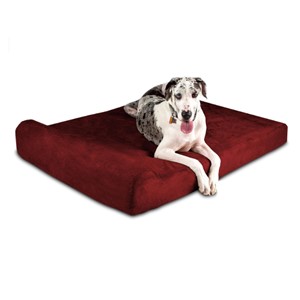
Big Barker Orthopedic Jumbo Bed w/Headrest
Price At Time of Publish $400.00
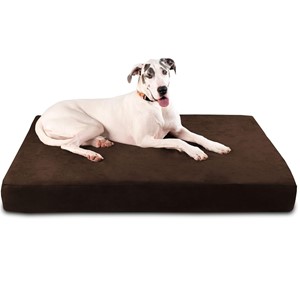
Big Barker Jumbo Orthopedic Rectangle Bed Chocolate
Price At Time of Publish $360.00
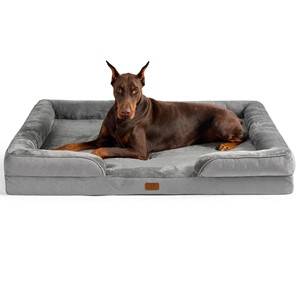
Bedsure Orthopedic Bolster XXL Dog Bed
Price At Time of Publish $85.00
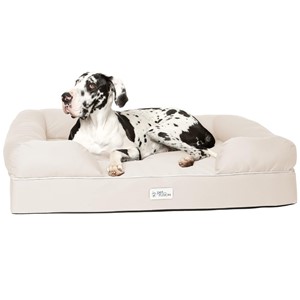
Petfusion Orthopedic Bolster XL Dog Bed
Price At Time of Publish $240.00
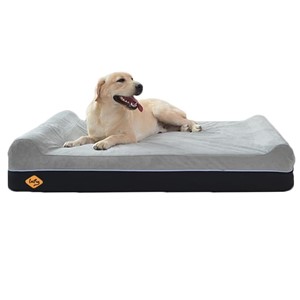
Laifug Orthopedic XL Dog Bed w/Pillow
Price At Time of Publish $130.00
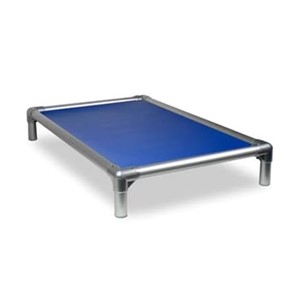
Kuranda Elevated Chewproof XXL Royal Dog Bed
Price At Time of Publish $197.00
Related Articles
Below are some articles that may be of interest to you. Just click or select the topic of interest and learn more about it.
- Are Crates Bad for Dogs
- Best Healthy Dog Food Brands
- Christmas Presents for My Dog
- Dog Parasite Symptoms
- How To Clean Dog Beds
- Ingredients To Avoid In Dog Treats
- Puppy Proofing Your House
- Signs Your Dog Is Ill
- Using Alexa for Dog Behaviors
- When Should A Dog Bed Be Replaced
Go back to the Dog Luxury Beds home page.
